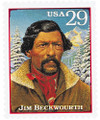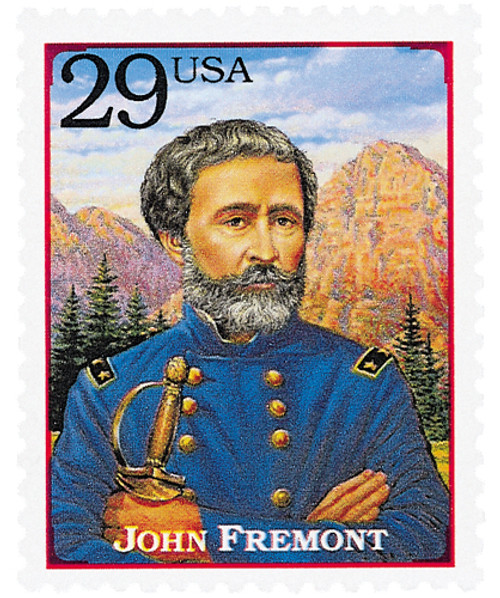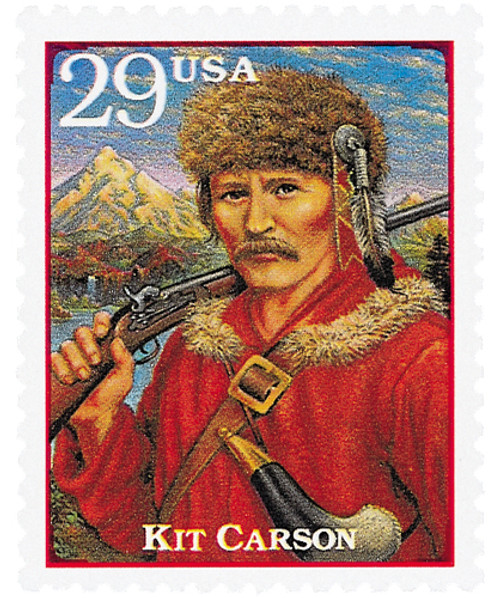
# 2869q - 1994 29c Legends of the West: Jim Beckwourth
U.S. #2869q
1994 29¢ Jim Beckwourth
Legends of the West
- From the corrected version of the famed Legends of the West error sheet
- First sheet in the Classic Collection Series
Stamp Category: Commemorative
Set: Legends of the West
Value: 29¢, rate for first-class mail
First Day of Issue: October 18, 1994
First Day Cities: Tucson, Arizona; Lawton, Oklahoma; Laramie, Wyoming
Quantity Issued: 19,282,800
Printed by: Stamp Venturers
Printing Method: Photogravure
Format: Panes of 20 in sheets of 120
Perforations: 10.2 x 10.1
Why the stamp was issued: The Legends of the West sheet was the first issue in the Classic Collection Series. It was developed from an idea to honor “Western Americana.”
About the stamp design: Stamp artist Mark Hess spent nearly two years working on the Legends of the West stamps. Hess based his portrait of Jim Beckwourth on a photo taken around 1860. He embellished it was a fur-collared coat and red scarf. It’s one of the few Legends of the West stamps with a distinct winter background.
Special design details: This stamp comes from the famed Legends of the West sheet, which made headlines due to two mistakes made by the United States Postal Service and led to a string of events without precedent in the history of US stamp collecting.
One of the people to be featured on the sheet was black rodeo star Bill Pickett. After the stamps were announced, but not officially issued, a radio reporter phoned Frank Phillips Jr., great-grandson of Bill Pickett, and asked him about the stamp. Phillips went to his local post office, looked at the design and recognized it as Ben Pickett – Bill’s brother and business associate. The stamp pictured the wrong man! That was the first mistake.
Phillips complained to the Postal Service and Postmaster General Marvin Runyon issued an order to recall and destroy the error stamps. Runyon also ordered new revised stamps be created – these are the corrected Legends of the West stamps – #2869.
But before the recall, 186 error sheets were sold by postal workers – before the official “first day of issue.” This was the second mistake. These error sheets were being resold for sums ranging from $3,000 to $15,000 each!
Several weeks later the US Postal Service announced that 150,000 error sheets would be sold at face value by means of a mail order lottery. This unprecedented move was made with the permission of Frank Phillips Jr. so the Post Office could recover its printing cost and not lose money. Sales were limited to one per household. The remaining stamps were destroyed.
About the printing process: In order to include the text on the back of the Legends of the West stamps, it had to be printed under the gum, so that it would still be visible if a stamp was soaked off an envelope. Because people would need to lick the stamps, the ink had to be approved by the Food and Drug Administration as non-toxic. The printer also used an extra-fine 300-line screen, which resulted in some of the highest-quality gravure stamp printings in recent years.
First Day Cities: The Laramie, Wyoming First Day ceremony was held at the University of Wyoming. The Tucson, Arizona ceremony was held at the Old Tucson Studios, where the High Chaparral TV series and several Western movies had been filmed. The Lawton, Oklahoma ceremony was held at Fort Sill, where Geronimo was buried.
About the Legends of the West: The Legends of the West sheet was ultimately born out of a discussion to issue a stamp to honor the 100th anniversary of Ellis Island in 1992. That plan was abandoned, but was Ellis Island was featured on a postal card in the Historic Preservation Series (#UX165). Talks then pivoted to a stamp honoring “Western Americana.” Stamp artist Mark Hess was tasked with producing four semi-jumbo stamp images capturing the colorful and graphic look of old Wild West show posters. The Citizens Stamp Advisory Committee (CSAC) discussed Hess’ images and decided to expand on the idea and honor 16 significant men and women that played major roles in the expansion of the West. At one point, they considered outlaws such as Butch Cassidy, Billy the Kid, and Jesse James, but ultimately decided to “come down on the side of right and justice.” The sheet of 20 had a decorative header and descriptive text was included on the back of each stamp.
The Legends of the West stamp designs were also adapted to postal cards, #UX178-97.
History the stamp represents:
James Pierson Beckwith (later Beckwourth) is believed to have been born on April 26, 1798 (or 1800), in Frederick County, Virginia. He was a figure from the old West, serving as a trapper, scout, trader, rancher, and more.
Born into slavery, Beckwourth’s father was also his master and he was the third of 13 children. His father moved them all to Missouri around 1809 and later apprenticed Jim to a blacksmith so he could learn a useful trade. He was eventually fired for arguing with the blacksmith. Beckwourth’s father emancipated him in 1824.
Beckwourth then went to school in St. Louis before joining the Rocky Mountain Fur Company as a wrangler. He learned the skills necessary to live in the wilderness, becoming a skilled trapper and mountain man. In 1825, a fellow trapper began spreading a rumor that Beckwourth was the child of a Crow chief and that he had been stolen by the Cheyenne and sold to a white family. Beckwourth normally wore Native American dress, and many believed the story.
Later that year, Beckwourth was reportedly mistaken for the lost son of a Crow chief and was accepted into their nation. (Some accounts claim the Rocky Mountain Fur Company planned this, to increase trade with the tribe.) For nearly nine years, Beckwourth lived with the Crow, married the daughter of a chief, distinguished himself in battle, and eventually became a high-ranking chief of the Dog Clan.
While with the Crow, Beckwourth also had a contract with the American Fur Company. When that contract was not renewed, he returned to St. Louis in 1837 and joined the US Army in the Second Seminole War. Over the next several years, Beckwourth worked as an Indian trader and ran a trading post in Pueblo, Colorado. For a time, he traded on the Old Spanish Trail in Mexico, but returned to the US to join the Army during the Mexican-American War, participating in the Taos Revolt.
Like many Americans, Beckwourth went west with the California gold rush of 1848. He opened a store in Sonoma and made a living for a time as a professional gambler. In 1850, Beckwourth discovered a pass through the Sierra Nevada Mountains, which was named in his honor. Located near present-day Reno, this pass became part of a major emigration route to California. The following year, he improved a Native American trail through the mountains, which was also named after him. The pass made it easier for settlers traveling to California to avoid 150 miles of dangerous terrain.
Beckwourth then opened a ranch, trading post, and hotel in the Sierra Valley, at a settlement that would become Beckwourth, California. In 1854, judge Thomas D. Bonner stayed at Beckwourth’s hotel for several months. During that time, Beckwourth told Bonner his life story. Bonner wrote it all down and turned it into a book, The Life and Adventures of James P. Beckwourth: Mountaineer, Scout and Pioneer, and Chief of the Crow Nation of Indians (1856). In addition to recounting Beckwourth’s life, the book is praised for its history of the Crow people and life in the West. Beckwourth was supposed to receive half of the money earned from the book’s sales, but never received any.
Beckwourth moved to Denver, Colorado, where he worked as a storekeeper and Indian agent. In 1864, he was made a scout with the 3rd Colorado Cavalry. He participated in actions against the Cheyenne and Apache, but was banned from trade with them after a massacre in which men, women, and children were killed. Beckwourth returned to trapping and was then made a scout during Red Cloud’s War. As his health declined, he returned to his former Crow village, where he died on October 28, 1866, or 1867.
U.S. #2869q
1994 29¢ Jim Beckwourth
Legends of the West
- From the corrected version of the famed Legends of the West error sheet
- First sheet in the Classic Collection Series
Stamp Category: Commemorative
Set: Legends of the West
Value: 29¢, rate for first-class mail
First Day of Issue: October 18, 1994
First Day Cities: Tucson, Arizona; Lawton, Oklahoma; Laramie, Wyoming
Quantity Issued: 19,282,800
Printed by: Stamp Venturers
Printing Method: Photogravure
Format: Panes of 20 in sheets of 120
Perforations: 10.2 x 10.1
Why the stamp was issued: The Legends of the West sheet was the first issue in the Classic Collection Series. It was developed from an idea to honor “Western Americana.”
About the stamp design: Stamp artist Mark Hess spent nearly two years working on the Legends of the West stamps. Hess based his portrait of Jim Beckwourth on a photo taken around 1860. He embellished it was a fur-collared coat and red scarf. It’s one of the few Legends of the West stamps with a distinct winter background.
Special design details: This stamp comes from the famed Legends of the West sheet, which made headlines due to two mistakes made by the United States Postal Service and led to a string of events without precedent in the history of US stamp collecting.
One of the people to be featured on the sheet was black rodeo star Bill Pickett. After the stamps were announced, but not officially issued, a radio reporter phoned Frank Phillips Jr., great-grandson of Bill Pickett, and asked him about the stamp. Phillips went to his local post office, looked at the design and recognized it as Ben Pickett – Bill’s brother and business associate. The stamp pictured the wrong man! That was the first mistake.
Phillips complained to the Postal Service and Postmaster General Marvin Runyon issued an order to recall and destroy the error stamps. Runyon also ordered new revised stamps be created – these are the corrected Legends of the West stamps – #2869.
But before the recall, 186 error sheets were sold by postal workers – before the official “first day of issue.” This was the second mistake. These error sheets were being resold for sums ranging from $3,000 to $15,000 each!
Several weeks later the US Postal Service announced that 150,000 error sheets would be sold at face value by means of a mail order lottery. This unprecedented move was made with the permission of Frank Phillips Jr. so the Post Office could recover its printing cost and not lose money. Sales were limited to one per household. The remaining stamps were destroyed.
About the printing process: In order to include the text on the back of the Legends of the West stamps, it had to be printed under the gum, so that it would still be visible if a stamp was soaked off an envelope. Because people would need to lick the stamps, the ink had to be approved by the Food and Drug Administration as non-toxic. The printer also used an extra-fine 300-line screen, which resulted in some of the highest-quality gravure stamp printings in recent years.
First Day Cities: The Laramie, Wyoming First Day ceremony was held at the University of Wyoming. The Tucson, Arizona ceremony was held at the Old Tucson Studios, where the High Chaparral TV series and several Western movies had been filmed. The Lawton, Oklahoma ceremony was held at Fort Sill, where Geronimo was buried.
About the Legends of the West: The Legends of the West sheet was ultimately born out of a discussion to issue a stamp to honor the 100th anniversary of Ellis Island in 1992. That plan was abandoned, but was Ellis Island was featured on a postal card in the Historic Preservation Series (#UX165). Talks then pivoted to a stamp honoring “Western Americana.” Stamp artist Mark Hess was tasked with producing four semi-jumbo stamp images capturing the colorful and graphic look of old Wild West show posters. The Citizens Stamp Advisory Committee (CSAC) discussed Hess’ images and decided to expand on the idea and honor 16 significant men and women that played major roles in the expansion of the West. At one point, they considered outlaws such as Butch Cassidy, Billy the Kid, and Jesse James, but ultimately decided to “come down on the side of right and justice.” The sheet of 20 had a decorative header and descriptive text was included on the back of each stamp.
The Legends of the West stamp designs were also adapted to postal cards, #UX178-97.
History the stamp represents:
James Pierson Beckwith (later Beckwourth) is believed to have been born on April 26, 1798 (or 1800), in Frederick County, Virginia. He was a figure from the old West, serving as a trapper, scout, trader, rancher, and more.
Born into slavery, Beckwourth’s father was also his master and he was the third of 13 children. His father moved them all to Missouri around 1809 and later apprenticed Jim to a blacksmith so he could learn a useful trade. He was eventually fired for arguing with the blacksmith. Beckwourth’s father emancipated him in 1824.
Beckwourth then went to school in St. Louis before joining the Rocky Mountain Fur Company as a wrangler. He learned the skills necessary to live in the wilderness, becoming a skilled trapper and mountain man. In 1825, a fellow trapper began spreading a rumor that Beckwourth was the child of a Crow chief and that he had been stolen by the Cheyenne and sold to a white family. Beckwourth normally wore Native American dress, and many believed the story.
Later that year, Beckwourth was reportedly mistaken for the lost son of a Crow chief and was accepted into their nation. (Some accounts claim the Rocky Mountain Fur Company planned this, to increase trade with the tribe.) For nearly nine years, Beckwourth lived with the Crow, married the daughter of a chief, distinguished himself in battle, and eventually became a high-ranking chief of the Dog Clan.
While with the Crow, Beckwourth also had a contract with the American Fur Company. When that contract was not renewed, he returned to St. Louis in 1837 and joined the US Army in the Second Seminole War. Over the next several years, Beckwourth worked as an Indian trader and ran a trading post in Pueblo, Colorado. For a time, he traded on the Old Spanish Trail in Mexico, but returned to the US to join the Army during the Mexican-American War, participating in the Taos Revolt.
Like many Americans, Beckwourth went west with the California gold rush of 1848. He opened a store in Sonoma and made a living for a time as a professional gambler. In 1850, Beckwourth discovered a pass through the Sierra Nevada Mountains, which was named in his honor. Located near present-day Reno, this pass became part of a major emigration route to California. The following year, he improved a Native American trail through the mountains, which was also named after him. The pass made it easier for settlers traveling to California to avoid 150 miles of dangerous terrain.
Beckwourth then opened a ranch, trading post, and hotel in the Sierra Valley, at a settlement that would become Beckwourth, California. In 1854, judge Thomas D. Bonner stayed at Beckwourth’s hotel for several months. During that time, Beckwourth told Bonner his life story. Bonner wrote it all down and turned it into a book, The Life and Adventures of James P. Beckwourth: Mountaineer, Scout and Pioneer, and Chief of the Crow Nation of Indians (1856). In addition to recounting Beckwourth’s life, the book is praised for its history of the Crow people and life in the West. Beckwourth was supposed to receive half of the money earned from the book’s sales, but never received any.
Beckwourth moved to Denver, Colorado, where he worked as a storekeeper and Indian agent. In 1864, he was made a scout with the 3rd Colorado Cavalry. He participated in actions against the Cheyenne and Apache, but was banned from trade with them after a massacre in which men, women, and children were killed. Beckwourth returned to trapping and was then made a scout during Red Cloud’s War. As his health declined, he returned to his former Crow village, where he died on October 28, 1866, or 1867.









